Quantification of Climate Warming and Crop Management Impacts on Cotton Phenology
Abstract
:1. Introduction
2. Results
2.1. Temperature Trend
2.2. Spatial and Temporal Changes in Phenological Stages of Cotton
2.3. Spatial and Temporal Changes in Phenological Phases of Cotton
2.4. Spatial and Temporal Changes in Thermal Characteristics for Cotton Cultivars
2.5. Correlation of Observed Phenology to Air Temperature
2.6. Correlation of Simulated Phenology to Air Temperature
2.7. Model-Predicted and Observed Phenology
3. Discussion
4. Materials and Methods
4.1. Description of Site, Weather, Cotton Management and Phenological Data
4.2. Analysis of Observed Data
4.3. CSM-CROPGRO-Cotton Model Descriptions
4.4. Phenology Simulation with CSM-CROPGRO-Cotton Model and Calculation of Growing Degree Days
4.5. Difference among Observing and Simulating Crop Phenological Respond to Temperature
5. Conclusions
Acknowledgments
Author Contributions
Conflicts of Interest
References
- Government of Pakistan (GOP). Economic Survey of Pakistan, Economic Advisory Wing; Government of Pakistan: Islamabad, Pakistan, 2014–2015; pp. 29–30.
- Reddy, K.R.; Vara Prasad, P.V.; Kakani, V.G. Crop responses to elevated carbon dioxide and interactions with temperature: Cotton. J. Crop Improv. 2005, 13, 157–191. [Google Scholar] [CrossRef]
- Song, Y.L.; Zhang, Q.; Dong, W.J. Impact of Climate Change on Cotton Production in Xingjiang Autonomous Region. Agric. Meteorol. 2004, 3, 15–20. [Google Scholar]
- Wang, H.L.; Gan, Y.T.; Wang, R.Y.; Niu, J.Y.; Zhao, H.; Yang, Q.G.; Li, G.C. Phenological trends in winter wheat and spring cotton in response to climate changes in northwest China. Agric. For. Meteorol. 2008, 148, 1242–1251. [Google Scholar] [CrossRef]
- Yoon, S.T.; Hoogenboom, G.; Flitcroft, I.; Bannayan, M. Growth and development of cotton (Gossypium hirsutum L.) in response to CO2 enrichment under two different temperature regimes. Environ. Exp. Bot. 2009, 67, 178–187. [Google Scholar] [CrossRef]
- Yang, Y.; Yang, Y.; Han, S.; Macadam, I.; Liu, D.L. Prediction of cotton yield and water demand under climate change and future adaptation measures. Agric. Water Manag. 2014, 144, 42–53. [Google Scholar] [CrossRef]
- Luo, Q.; Bange, M.; Johnston, D.; Braunack, M. Cotton crop water use and water use efficiency in a changing climate. Agric. Ecosyst. Environ. 2015, 202, 126–134. [Google Scholar] [CrossRef]
- Huang, J.; Ji, F. Effects of climate change on phenological trends and seed cotton yields in oasis of arid regions. Int. J. Biometeorol. 2015, 59, 877–888. [Google Scholar] [CrossRef] [PubMed]
- Intergovernmental Panel on Climate Change (IPCC). Climate Change 2014: Impacts, Adaptation, and Vulnerability; Fifth Assessment Report on the Intergovernmental Panel on Climate Change; Cambridge University Press: Cambridge, NY, USA, 2014; p. 688. [Google Scholar]
- Yihui, D.; Guoyu, R.; Guangyu, S.; Peng, G.; Xunhua, Z.; Panmao, Z.; De’er, Z.; Zongci, Z.; Shaowu, W.; Huijun, W.; et al. China’s National Assessment Report on Climate Change (I): Climate change in China and the future trend. Adv. Clim. Change Res. 2007, 3 (Suppl.), 1–5. [Google Scholar]
- Wang, S.Y.; Davies, R.E.; Huang, W.R.; Gillies, R.R. Pakistan’s two-stage monsoon and links with the recent climate change. J. Geophys. Res. Atmos. 2011. [Google Scholar] [CrossRef]
- Gordo, O.; Sanz, J.J. Phenology and climate change: A long-term study in a Mediterranean locality. Oecoloqia 2005, 146, 484–495. [Google Scholar] [CrossRef] [PubMed]
- Craufurd, P.Q.; Wheeler, T.R. Climate change and the flowering time of annual crops. J. Exp. Bot. 2009, 60, 2529–2539. [Google Scholar] [CrossRef] [PubMed]
- Beamish, A.L.; Nijland, W.; Edwards, M.; Coops, N.C.; Henry, G.H.R. Phenology and vegetation change measurements from true colour digital photography in high Arctic tundra. Arct. Sci. 2016, 2, 33–49. [Google Scholar] [CrossRef]
- Chmielewski, F.-M.; Muller, A.; Bruns, E. Climate changes and trends in phenology of fruit trees and field crops in Germany, 1961–2000. Agric. For. Meteorol. 2004, 121, 69–78. [Google Scholar] [CrossRef]
- Estrella, N.; Sparks, T.H.; Menzel, A. Trends and temperature response in the phenology of crops in Germany. Global Change Biol. 2007, 13, 1737–1747. [Google Scholar] [CrossRef]
- Zhenyong, D.; Heling, W.; Guochang, L.; Jiwu, X.; Yufei, Z.; Jinfang, X. Study on the cause of formation and countermeasure effect of climate warming on cotton produce in Hexi corridor. Adv. Earth Sci. 2008, 23, 160–166. [Google Scholar]
- Cottee, N.S.; Tan, D.K.Y.; Bange, M.P.; Cothren, J.T.; Campbell, L.C. Multi-Level determination of heat tolerance in cotton (Gossypium hirsutum L.) under field conditions. Crop Sci. 2010, 50, 2553–2564. [Google Scholar] [CrossRef]
- Ahmad, S.; Nadeem, M.; Abbas, G.; Fatima, Z.; Khan, R.J.Z.; Ahmed, M.; Ahmad, A.; Rasul, G.; Khan, M.A. Quantification of the effects of climate warming and crop management on sugarcane phenology. Clim. Res. 2016, 71, 47–61. [Google Scholar] [CrossRef]
- Menzel, A.; Sparks, T.H.; Estrella, N.; Koch, E.; Aasa, A.; Ahas, R.; Alm-Kubler, K.; Bissolli, P.; Braslavska, O.; Briede, A.; et al. European phenological response to climate change matches the warming pattern. Glob. Chang. Biol. 2006, 12, 1969–1976. [Google Scholar] [CrossRef]
- Xiao, D.; Tao, F. Contributions of cultivars, management and climate change to winter wheat yield in the North China Plain in the past three decades. Eur. J. Agron. 2014, 52, 112–122. [Google Scholar] [CrossRef]
- Hoffmann, A.A.; Sgrò, C.M. Climate change and evolutionary adaptation. Nature 2011, 470, 479–485. [Google Scholar] [CrossRef] [PubMed]
- Ahmad, A.; Ashfaq, M.; Rasul, G.; Wajid, S.A.; Khaliq, T.; Rasul, F.; Saeed, U.; Habib ur Rahman, M.; Hussain, J.; Baig, I.A.; et al. Impact of climate change on the rice-wheat cropping system of Pakistan. In Handbook of Climate Change and Agro-Ecosystems; Hillel, D., Rosenzweig, C., Eds.; Imperial College Press: London, UK; The American Society of Agronomy: Madison, WI, USA, 2015; Volume 3, pp. 219–258. [Google Scholar]
- Anwar, M.R.; Liu, D.L.; Farquharson, R.; Macadam, I.; Abadi, A.; Finlayson, J.; Wang, B.; Ramilan, T. Climate change impacts on phenology and yields of five broadacre crops at four climatologically distinct locations in Australia. Agric. Syst. 2015, 132, 133–144. [Google Scholar] [CrossRef]
- Liu, Z.; Yuan, Y.L.; Liu, S.Q.; Yu, X.N.; Rao, L.Q. Screening for high-temperature tolerant cotton cultivars by testing in vitro pollen germination, pollen tube growth and boll retention. J. Integrat. Plant Biol. 2006, 48, 706–714. [Google Scholar] [CrossRef]
- Singh, R.P.; Vara Prasad, P.V.; Sunita, K.; Giri, S.N.; Reddy, K.R. Influence of high temperature and breeding for heat tolerance in cotton: A review. Adv. Agron. 2007, 93, 313–385. [Google Scholar]
- Wolkovich, E.M.; Cook, B.I.; Allen, J.M.; Crimmins, T.M.; Betancourt, J.L.; Travers, S.E.; Pau, S.; Regetz, J.; Davies, T.J.; Kraft, N.J.B.; et al. Warming experiments underpredict plant phenological responses to climate change. Nature 2012, 485, 494–497. [Google Scholar] [CrossRef] [PubMed]
- Dounias, I.; Aubry, C.; Capillon, A. Decision-making processes for crop management on African farms. Modelling from a case study of cotton crops in northern Cameroon. Agric. Syst. 2002, 73, 233–260. [Google Scholar] [CrossRef]
- Ortiz, B.V.; Hoogenboom, G.; Vellidis, G.; Boote, K.; Davis, R.F.; Perry, C. Adapting the CROPGRO-Cotton model to simulate cotton biomass and yield under southern root-knot nematode parasitism. Trans. ASAE 2009, 52, 2129–2140. [Google Scholar] [CrossRef]
- Boote, K.J.; Jones, J.W.; Hoogenboom, G.; White, J.W. The role of crop systems simulation in agriculture and environment. Int. J. Agric. Environ. Inf. Syst. 2010, 1, 41–54. [Google Scholar] [CrossRef]
- Pathak, T.B.; Jones, J.W.; Fraisse, C.W.; Wright, D.; Hoogenboom, G. Uncertainty analysis and parameter estimation for the CSM-CROPGRO-Cotton model. Agron. J. 2012, 104, 1363–1373. [Google Scholar] [CrossRef]
- Thorp, K.R.; Barnes, E.M.; Hunsaker, D.J.; Kimball, B.A.; White, J.W.; Nazareth, V.J.; Hoogenboom, G. Evaluation of CSM-CROPGRO-Cotton for simulating effects of management and climate change on cotton growth and evapotranspiration in an arid environment. Trans. ASAE 2014, 57, 1627–1642. [Google Scholar]
- Modala, N.R.; Ale, S.; Rajan, N.; Munster, C.L.; DeLaune, P.B.; Thorp, K.R.; Nair, S.S.; Barnes, E.M. Evaluation of the CSM-CROPGRO-Cotton model for the Texas rolling plains region and simulation of deficit irrigation strategies for increasing water use efficiency. Trans. ASAE 2015, 58, 685–696. [Google Scholar]
- White, J.W.; Hoogenboom, G.; Hunt, L.A. A structured procedure for assessing how crop models respond to temperature. Agron. J. 2005, 96, 426–439. [Google Scholar] [CrossRef]
- Liu, Y.; Wang, E.; Yang, X.; Wang, J. Contributions of climatic and crop varietal changes to crop production in the North China Plain, since 1980s. Glob. Chang. Biol. 2010, 16, 2287–2299. [Google Scholar] [CrossRef]
- Cleland, E.E.; Chuine, I.; Menzel, A.; Mooney, H.A.; Schwartz, M.D. Shifting plant phenology in response to global change. Trends Ecol. Evol. 2007, 22, 357–365. [Google Scholar] [CrossRef] [PubMed]
- Braunack, M.V. Cotton farming systems in Australia: Factors contributing to changed yield and fibre quality. Crop Pasture Sci. 2013, 64, 834–844. [Google Scholar]
- Karademir, E.; Karademir, C.; Ekinci, R.; Basbag, S.; Basal, H. Screening cotton varieties (Gossypium hirsutum L.) for heat tolerance under field conditions. Afr. J. Agric. Res. 2012, 7, 6335–6342. [Google Scholar]
- Khan, N.; Azhar, F.M.; Khan, A.A.; Ahmad, R. Measurement of canopy temperature for heat tolerance in upland cotton: Variability and its genetic basis. Pak. J. Agri. Sci. 2014, 51, 359–365. [Google Scholar]
- Abro, S.; Rajput, M.T.; Khan, M.A.; Sial, M.A.; Tahir, S.S. Screening of cotton (Gossypium hirsutum L.) genotypes for heat tolerance. Pak. J. Bot. 2015, 47, 2085–2091. [Google Scholar]
- Visser, M.E.; Both, C. Shifts in phenology due to global climate change: The need for a yardstick. Proc. Biol. Sci. 2005, 272, 2561–2569. [Google Scholar] [CrossRef] [PubMed]
- He, L.; Asseng, S.; Zhao, G.; Wu, D.; Yang, X.; Zhuang, W.; Jin, N.; Yu, Q. Impacts of recent climate warming, cultivar changes, and crop management on winter wheat phenology across the Loess Plateau of China. Agric. For. Meteorol. 2015, 200, 135–143. [Google Scholar] [CrossRef]
- Zheng, J.; Ge, Q.; Hao, Z. Impacts of climate warming on plant phenophases in China for the last 40 years. Chin. Sci. Bull. 2002, 47, 1826–1831. [Google Scholar] [CrossRef]
- Zhang, T.; Huang, Y. Estimating the impacts of warming trends on wheat and maize in China from 1980 to 2008 based on county level data. Int. J. Climatol. 2013, 33, 699–708. [Google Scholar] [CrossRef]
- Qingchun, L.; Huaisui, Q.; Yuyu, R.; Tuxing, J. Temperature suitability of cotton and its changes in Henan Province. Resour. Sci. 2003, 26, 51–56. [Google Scholar]
- Bednarz, C.W.; Nichols, R.L. Phenological and morphological components of cotton crop maturity. Crop Sci. 2005, 45, 1497–1503. [Google Scholar] [CrossRef]
- Luo, Q.; Bange, M.; Clancy, L. Cotton crop phenology in a new temperature regime. Ecol. Modell. 2014, 285, 22–29. [Google Scholar] [CrossRef]
- Tao, F.; Yokozawa, M.; Xu, Y.; Hayashi, Y.; Zhang, Z. Climate changes and trends in phenology and yields of field crops in China, 1981–2000. Agric. For. Meteorol. 2006, 138, 82–92. [Google Scholar] [CrossRef]
- García-Mozo, H.; Mestre, A.; Galán, C. Phenological trends in southern Spain: A response to climate change. Agric. For. Meteorol. 2010, 150, 575–580. [Google Scholar] [CrossRef]
- Rasul, G.; Mahmood, A.; Sadiq, A.; Khan, S.I. Vulnerability of the Indus delta to climate change in Pakistan. Pak. J. Meterol. 2012, 8, 89–107. [Google Scholar]
- Richardson, A.D.; Keenan, T.F.; Migliavacca, M.; Ryu, Y.; Sonnentag, O.; Toomey, M. Climate change, phenology, and phenological control of vegetation feedbacks to the climate system. Agric. For. Meteorol. 2013, 169, 156–173. [Google Scholar] [CrossRef]
- White, J.W.; Hoogenboom, G. Crop response to climate: Ecophysiological models. In Climate Change and Food Security; Lobell, D., Burke, M., Eds.; Springer Science: Dordrecht, The Netherlands, 2010; Volume 37, pp. 59–83. [Google Scholar]
- Soliz, L.M.A.; Oosterhuis, D.M.; Coker, D.L.; Brown, R.S. Physiological response of cotton to high night temperature. Am. J. Plant Sci. Biotechnol. 2008, 2, 63–68. [Google Scholar]
- Jones, J.W.; Hoogenboom, G.; Porter, C.H.; Boote, K.J.; Batchelor, W.D.; Hunt, L.A.; Wilkens, P.W.; Singh, U.; Gijsman, A.J.; Ritchie, J.T. The DSSAT cropping system model. Eur. J. Agron. 2003, 18, 235–265. [Google Scholar] [CrossRef]
- Hoogenboom, G.; Jones, J.W.; Wilkens, P.W.; Porter, C.H.; Boote, K.J.; Hunt, L.A.; Singh, U.; Lizaso, J.I.; White, J.W.; Uryasev, O.; et al. Decision Support System for Agrotechnology Transfer (DSSAT) 2015, Version 4.6.1; DSSAT Foundation: Prosser, WA, USA, 2015; Available online: www.dssat.net (accessed on 11 March 2016).
- Ahmad, S.; Abbas, G.; Fatima, Z.; Khan, R.J.Z.; Anjum, M.A.; Ahmed, M.; Khan, M.A.; Porter, C.H.; Hoogenboom, G. Quantification of the impacts of climate warming and crop management on canola phenology in Punjab, Pakistan. J. Agron. Crop Sci. 2017, in press. [Google Scholar]
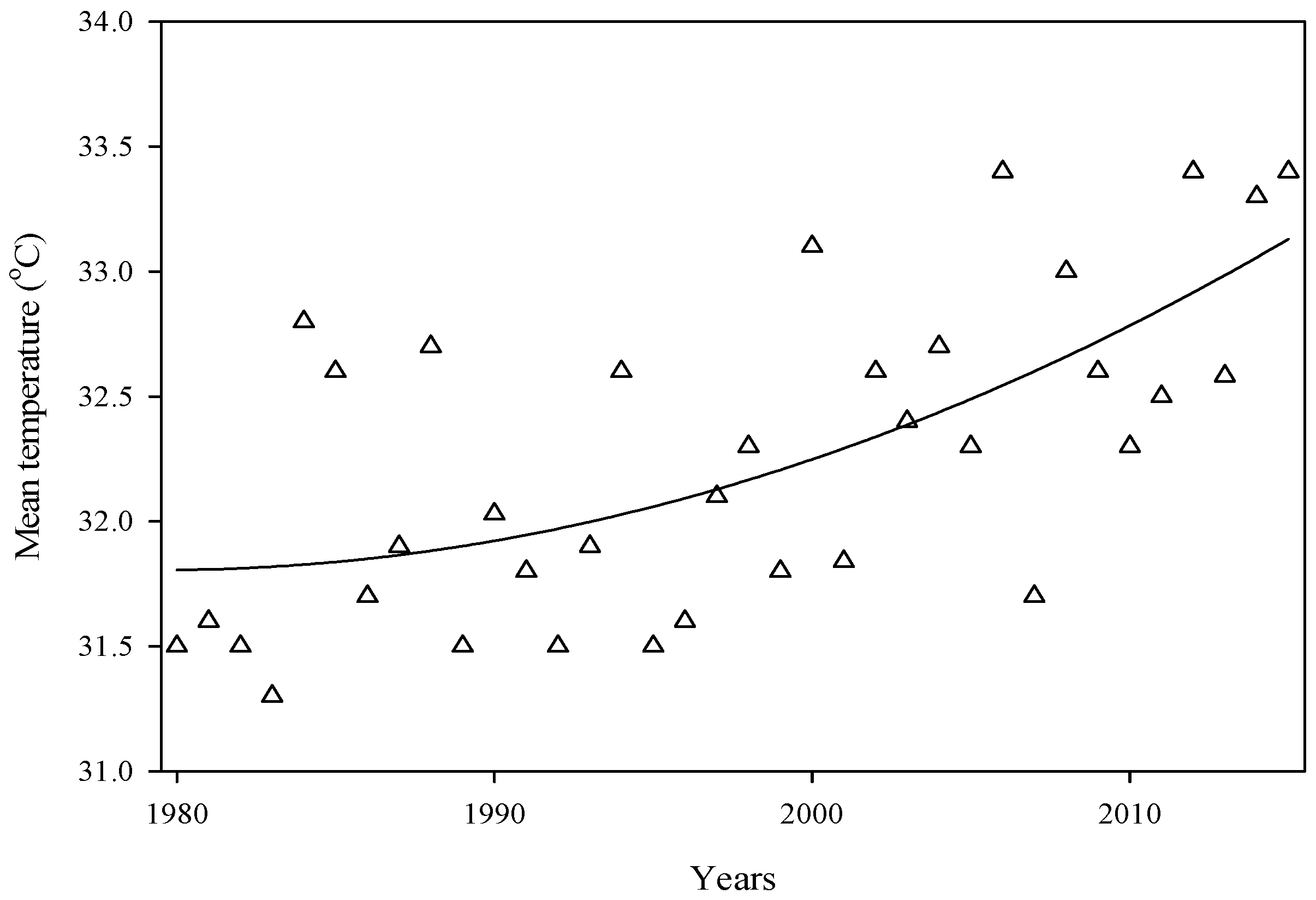

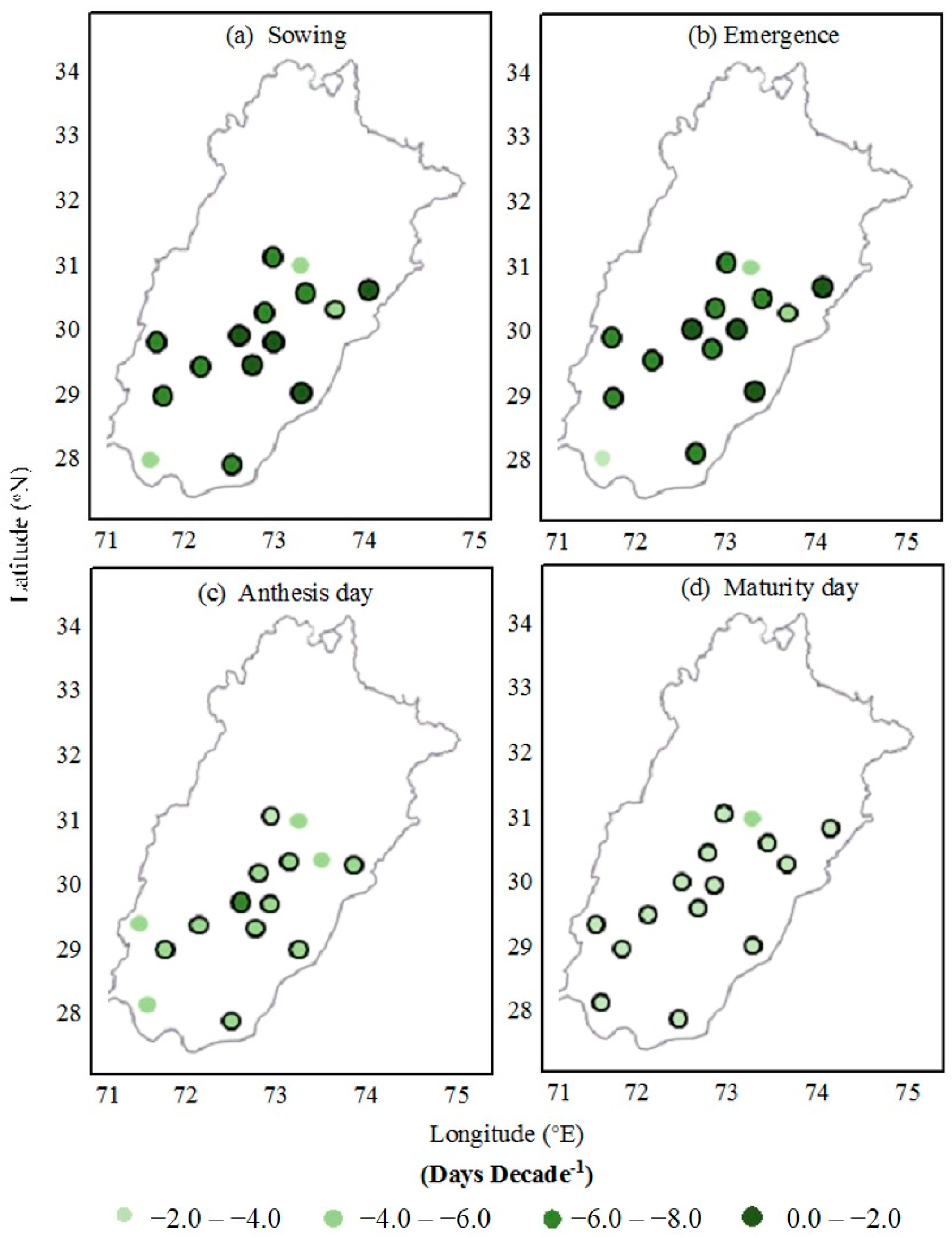
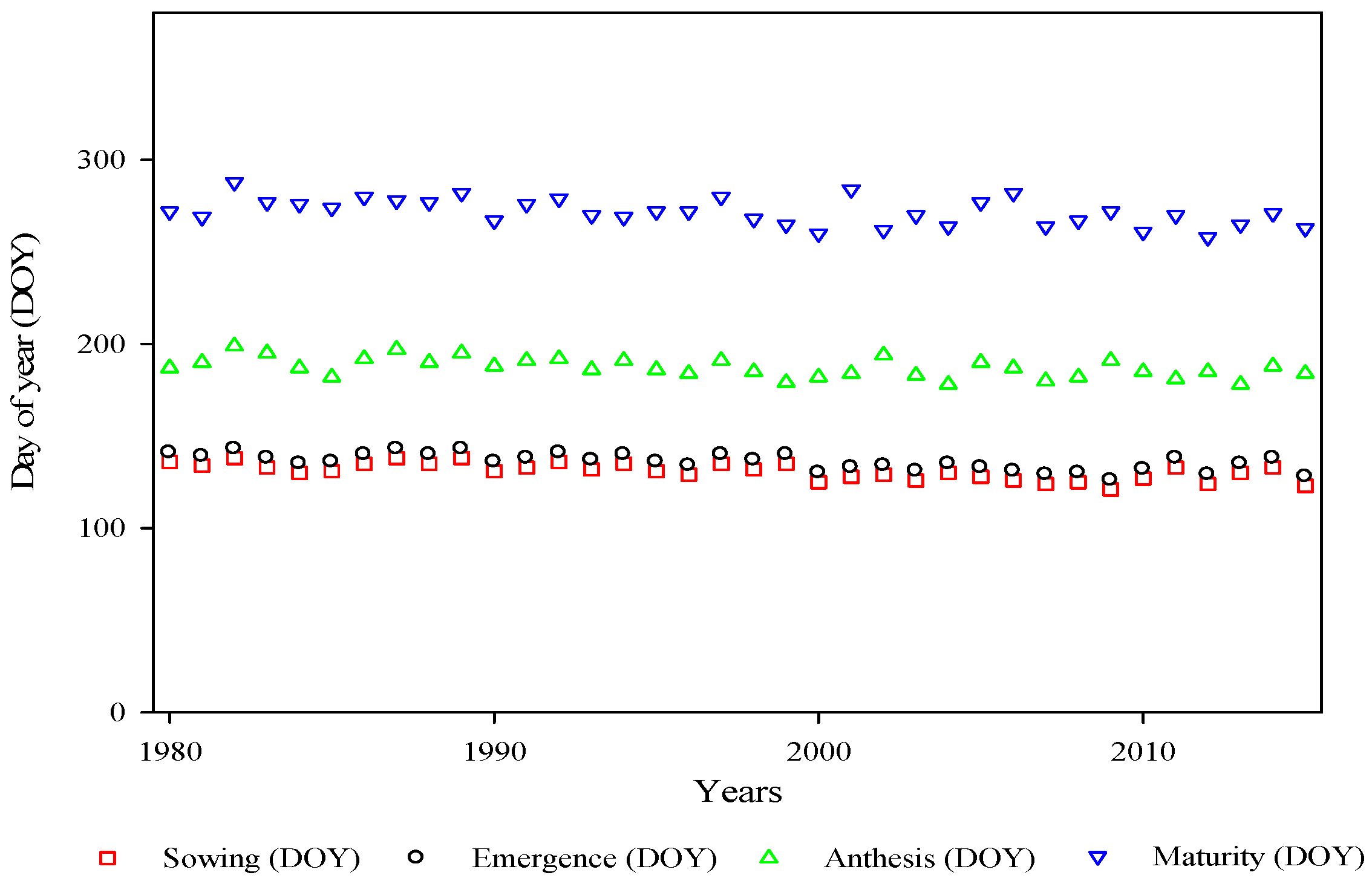

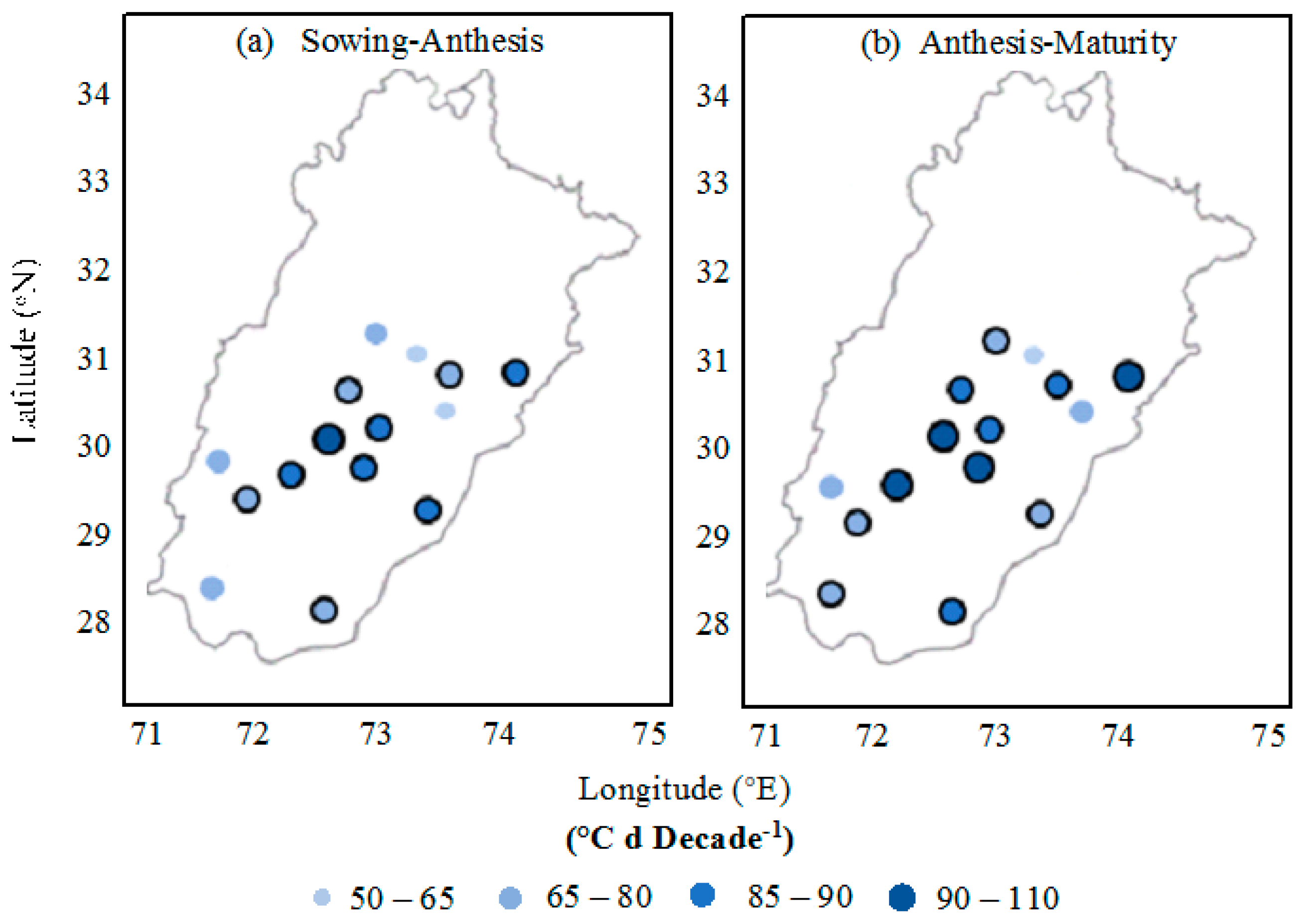
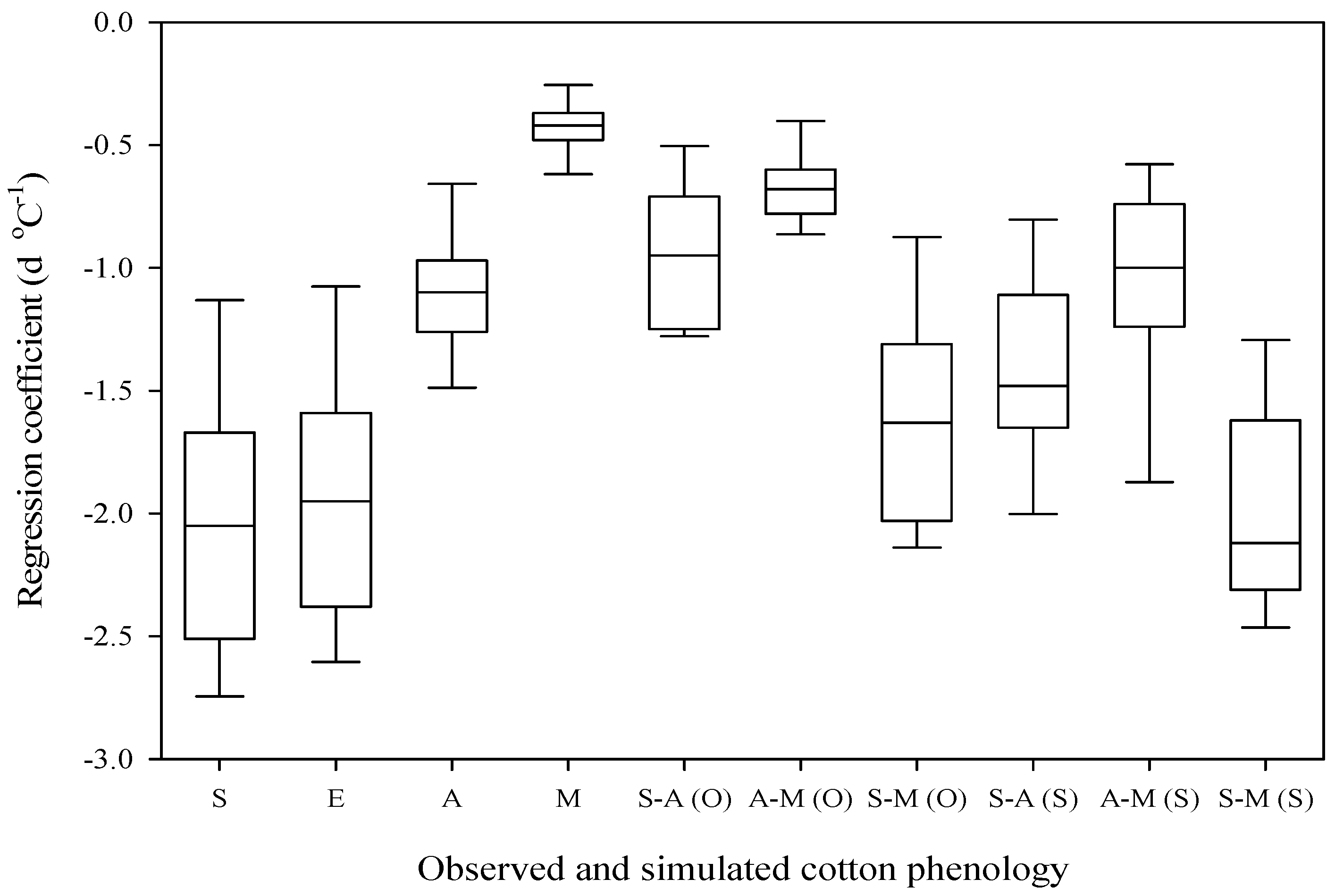

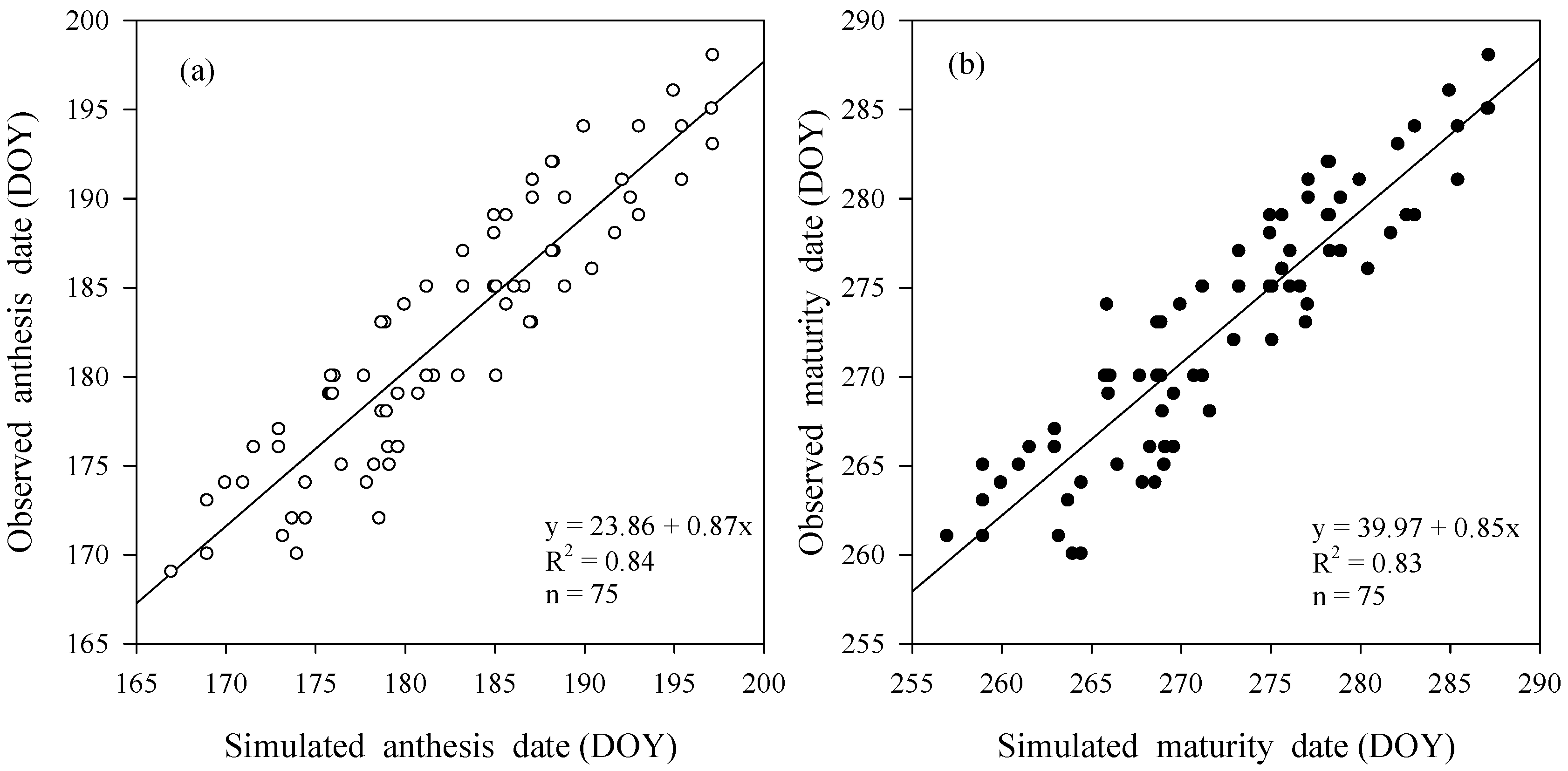
| Districts | Sowing DOY | EmergenceDOY | Anthesis a DOY | Maturity b DOY |
|---|---|---|---|---|
| Toba Tek Singh | 119 ± 7.0 | 124 ± 6.4 | 190 ± 5.4 | 274 ± 9.3 |
| Jhang | 121 ± 6.2 | 126 ± 5.7 | 188 ± 3.5 | 281 ± 7.3 |
| Okara | 128 ± 5.7 | 133 ± 5.3 | 191 ± 7.2 | 273 ± 5.4 |
| Sahiwal | 123 ± 7.2 | 128 ± 6.9 | 182 ± 6.1 | 278 ± 8.3 |
| Pakpattan | 130 ± 5.2 | 135 ± 5.0 | 189 ± 5.9 | 270 ± 7.8 |
| Multan | 120 ± 4.3 | 125 ± 4.1 | 191 ± 7.2 | 281 ± 6.7 |
| Khanewal | 125 ± 5.0 | 130 ± 4.8 | 193 ± 8.4 | 276 ± 5.5 |
| Vehari | 128 ± 6.7 | 133 ± 6.2 | 197 ± 9.2 | 285 ± 7.2 |
| Lodhran | 125 ± 4.4 | 130 ± 4.1 | 189 ± 6.2 | 278 ± 8.1 |
| Bahawalnagar | 131 ± 3.8 | 136 ± 3.5 | 192 ± 8.1 | 272 ± 9.5 |
| Bahawalpur | 130 ± 5.1 | 135 ± 4.5 | 187 ± 4.9 | 282 ± 8.5 |
| DG Khan | 126 ± 4.2 | 131 ± 3.9 | 183 ± 5.8 | 276 ± 6.7 |
| Rajanpur | 122 ± 6.9 | 127 ± 6.3 | 190 ± 7.3 | 280 ± 7.6 |
| Muzaffargarh | 127 ± 5.2 | 132 ± 4.7 | 194 ± 6.1 | 276 ± 7.1 |
| Rahim Yar Khan | 123 ± 4.8 | 128 ± 3.9 | 197 ± 6.8 | 270 ± 8.6 |
| Phenology | No. neg. a | No. pos. b | No. sig. neg. c | No. sig. pos. d | Reg. Mean e (days °C−1) |
|---|---|---|---|---|---|
| Cotton stages and phases (observed) | |||||
| Sowing | 15 | 0 | 13 | 0 | −2.03 |
| Emergence | 15 | 0 | 13 | 0 | −1.93 |
| Anthesis | 15 | 0 | 11 | 0 | −1.09 |
| Maturity | 15 | 0 | 14 | 0 | −0.42 |
| Sowing-Anthesis | 15 | 0 | 12 | 0 | −0.94 |
| Anthesis-Maturity | 15 | 0 | 11 | 0 | −0.67 |
| Sowing-Maturity | 15 | 0 | 13 | 0 | −1.61 |
| Cotton phases (simulated) | |||||
| Sowing-Anthesis | 15 | 0 | 14 | 0 | −1.42 |
| Anthesis-Maturity | 15 | 0 | 13 | 0 | −1.06 |
| Sowing-Maturity | 15 | 0 | 14 | 0 | −1.97 |
| Phenology (Phases) | Regression Coefficient a (days °C−1) | Difference between obs. and sim. Regression Correlations (Days °C−1) | t-Test (p-Value) | |
|---|---|---|---|---|
| Observed Data | Simulated Data | |||
| Sowing-Anthesis | −0.94 | −1.42 | 0.48 | 0.0012 ** |
| Anthesis-Maturity | −0.67 | −1.06 | 0.39 | 0.0053 ** |
| Sowing-Maturity | −1.61 | −1.97 | 0.36 | 0.0021 ** |
| Sr. No. | Site Name | Cultivars |
|---|---|---|
| 1 | Toba Tek Singh | CIM-506a, FH-901e, FDH-228b, CYTO-124, BH-3297, B-803, MNH-552, IR-1524 |
| 2 | Jhang | CIM-499a, CIM-446e, MS-240, Sitara-005, SLH-8, FH-685, BH-100a, NS-141 |
| 3 | Okara | CIM-534c, CIM-554e, IR-1274, MNH-998, FH-901, CIM-110, CIM-435, CIM-602 |
| 4 | Sahiwal | NIAB-111c, CIM-473d, GN-1532, CEMB-66, B-896, CIM-70, B-622, FVH-55 |
| 5 | Pakpattan | BH-160e, MNH-786a, CIM-109, NIBGE-901, AGC-777, NIBGE-6, FS-631, CIM-240 |
| 6 | Multan | IR-3701, CIM-240, CIM-1100, NIBGE-2d, AGC-999, CIM-109, B-820, BH-118 |
| 7 | Khanewal | MG-6, NIAB-846d, CIM-707, Sitara-12, NIAB-2008e, S-12, MNH-554, FVH-57 |
| 8 | Vehari | Sitara-008, NIAB-777d, CIM-600, FH-142, TCD-3, CIM-482a, MNH-93, VH-259 |
| 9 | Lodhran | FH-113, CRSM-38d, TS-103, CYTO-177, FH-628b, FH-87, FH-657, MNH-516 |
| 10 | Bahawalnagar | Neelam-121c, AH-151d, Tarzan-3, B-842, CIM-465c, RH-500, SLS-1, Tarzan-1 |
| 11 | Bahawalpur | Ali Akbar-802, S-14 , MNH-786a, Leader-1, FDH-170b, NIAB-78, B-821, NIAB-26 |
| 12 | DG Khan | IR-1524, NIBGE-1e, VH-305, FH-113, TSR-2375, Karishma, CIM-467, VH-137 |
| 13 | Rajanpur | GN-2085, NIAB-846e, IUB-13, MS-240, MNH-465, BH-95, FH-649, MNH-536 |
| 14 | Muzaffargarh | CIM-496c, Desi Ravib, FH-Lalazar, 149-F, S-12, FH-629, MVH-518, VS-135 |
| 15 | Rahim Yar Khan | Ali Akbar-703, FDH-170b, AC-134, MM-58, CIM-448a, B-803, FVH-49, NIAB-846 |
© 2017 by the authors; licensee MDPI, Basel, Switzerland. This article is an open access article distributed under the terms and conditions of the Creative Commons Attribution (CC BY) license (http://creativecommons.org/licenses/by/4.0/).
Share and Cite
Ahmad, S.; Abbas, Q.; Abbas, G.; Fatima, Z.; Atique-ur-Rehman; Naz, S.; Younis, H.; Khan, R.J.; Nasim, W.; Habib ur Rehman, M.; et al. Quantification of Climate Warming and Crop Management Impacts on Cotton Phenology. Plants 2017, 6, 7. https://doi.org/10.3390/plants6010007
Ahmad S, Abbas Q, Abbas G, Fatima Z, Atique-ur-Rehman, Naz S, Younis H, Khan RJ, Nasim W, Habib ur Rehman M, et al. Quantification of Climate Warming and Crop Management Impacts on Cotton Phenology. Plants. 2017; 6(1):7. https://doi.org/10.3390/plants6010007
Chicago/Turabian StyleAhmad, Shakeel, Qaiser Abbas, Ghulam Abbas, Zartash Fatima, Atique-ur-Rehman, Sahrish Naz, Haseeb Younis, Rana Jahanzeb Khan, Wajid Nasim, Muhammad Habib ur Rehman, and et al. 2017. "Quantification of Climate Warming and Crop Management Impacts on Cotton Phenology" Plants 6, no. 1: 7. https://doi.org/10.3390/plants6010007







